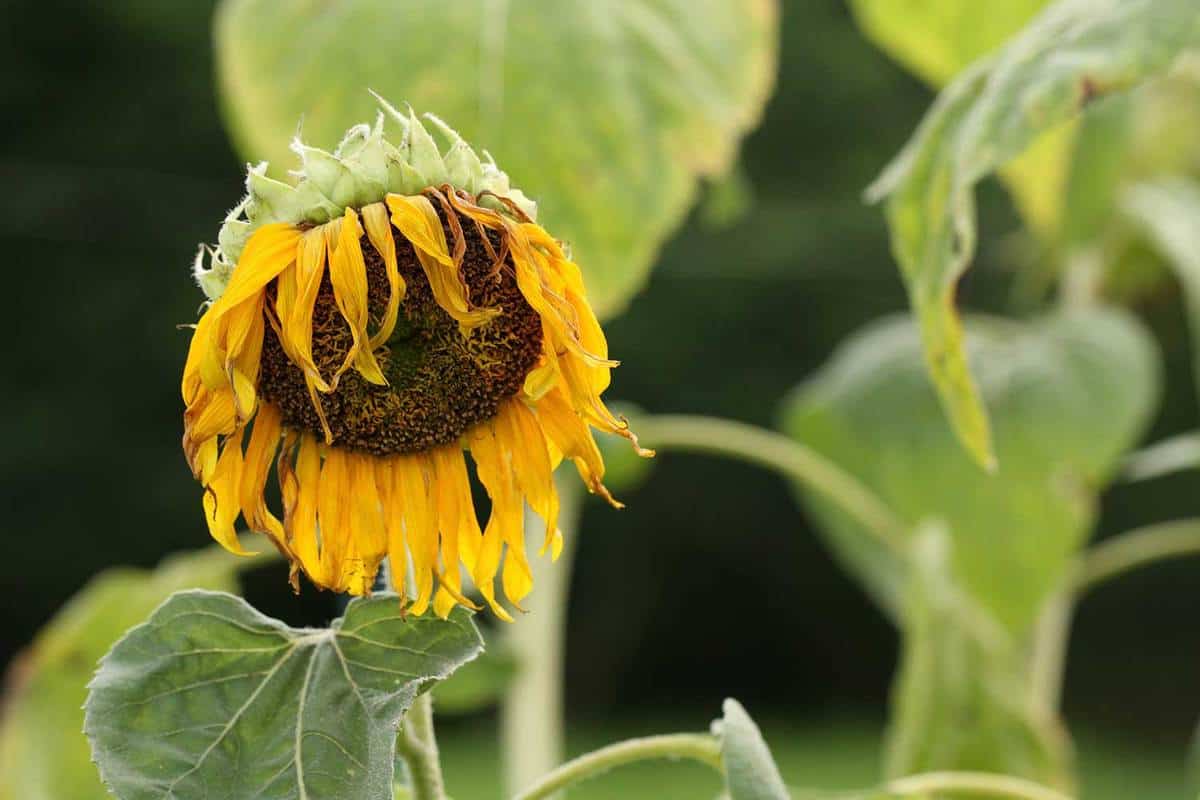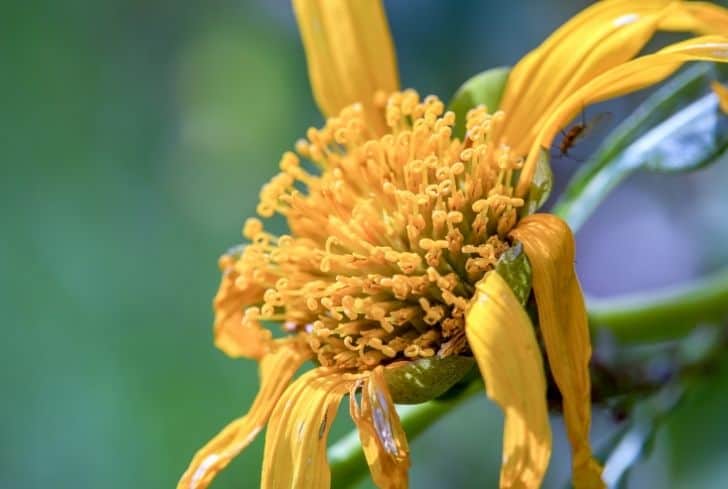
Sunlight deficiency or root rot brought on by overwatering and poorly draining soils are the usual causes of sunflower death. Sunflowers require 6 to 8 hours of daily light and well-draining soil. The leaves turn yellow with a drooping, dead appearance if the soil is persistently moist. Sunflowers wither and lose their leaves under excessive shade.
Sunlight deficiency or a small pot are the causes of sunflowers dying indoors.
Smaller pots retain less soil, which depletes the soil’s moisture and nutrients. The large roots of the sunflower are unable to absorb the water and nutrients they require in small pots, which causes the plant to appear drooping and dead.
Sunflower seedlings that are drooping and dying are sometimes caused by their immature root systems not having access to enough moisture or by high temperatures.
It is important to keep in mind that the majority of sunflower cultivars are annuals, meaning they only last one year before withering away.
To learn how to put the answers to save your dying sunflower (Helianthus annuus), keep reading.
Table of Contents
Sunflower Drooping and Dying
- Symptoms. The leaves could droop and turn brown or yellow. Likewise, flower heads may droop.
- Causes. Slow-draining soils or excessive irrigation help to create the fungus that causes yellow, drooping leaves. Wilting is a result of insufficient sunlight. In alkaline soils, leaves turn brown or yellow. Each year, cold weather causes sunflowers to droop and eventually die.
Sunflowers demand full light and can withstand drought once established. They are native to relatively hot and arid areas in the Western United States.
Therefore, excessive moisture around the roots is more frequently the cause of a sunflower drooping and dying than insufficient moisture.
Sunflowers prefer to grow in organically dense soil that retains moisture but drains well.
The sunflower’s leaves and flower heads may droop and turn yellow if it receives excessive watering or if it is placed in heavy, soggy soils like clay. This is because the roots cannot breathe and cannot absorb the moisture and nutrients the plant need.
Muddy circumstances also favor the growth of rust, mildew, and other fungi diseases.
A wilting sunflower is frequently caused by inadequate sunshine. Sunflowers grow tall and in broad spaces in their natural habitat, giving them an advantage over other plants in the race for sunshine.
Sunlight exposure of 8 to 10 hours is said to be ideal for sunflower growth and flowering. Although sunflowers can survive with less light hours, there is a greater chance that they will droop and their bottom leaves will turn brown and die.
Additionally, while certain varieties of sunflowers are perennials and return year after year, most sunflower varieties are annuals and only live for one year before withering.
Sunflowers are more vulnerable to cold than the majority of garden ornamental plants, therefore cold weather poses a threat to them as well. A withering sunflower with brown leaves may be the result of an unexpected cold spell or frost.
In general, it is advised to wait until the risk of frost has gone and the weather has warmed up before planting out any sunflowers from seeds or plug plants (so the roots can grow) if the soil temperature is below 60°F (16°C).
Although established sunflowers can tolerate heat, wilting leaves and dying plants can occur if young sunflowers do not have access to enough moisture due to high temperatures and little rainfall. It is crucial to water young sunflowers liberally twice a week in the first 60 days to encourage healthy roots.
Additionally, it should be mentioned that sunflowers prefer soils with a pH between 6 and 8. Alkaline soil (soils with a pH higher than 7) can cause the leaves to turn yellow or brown, grow slowly, and appear to be dying.
How to Revive a Sunflower Drooping and Dying

Cold snaps can cause harm to sunflowers, but whether or not they recover depends on the severity of the damage. Frosts typically cause sunflowers to die back.
To give sunflowers the best chance of surviving in cool or unpredictable climates, I advise growing them indoors for 4 weeks as plug plants on a sunny window sill in compostable pots, and then consulting a long-range weather forecast before planting them outdoors, if you live in a climate where springtime frost is a threat.
The ideal time to plant sunflowers is when the soil temperature is 60°F (16°C).
The sunflower should recover in the coming weeks if the causes of its withering have been addressed. This includes moving it to a location with full sun and making sure the soil is wet but not soggy.
Indoor Potted Sunflowers Wilting and Dying
- Symptoms. Sunflowers cultivated inside may have drooping leaves and flower heads or may not blossom at all.
- Causes. Small pots, insufficient sunlight, or watering issues are the main culprits.
Sunflowers grown inside frequently die because they lack adequate light. Although they may be cultivated inside, sunflowers require at least six hours of sunlight each day. The sunflower will not flower and will appear to be dying if it is kept in too much shade inside.
Sunflowers must be placed on a South-facing window sill where they receive at least 6 hours of light each day (but ideally 8 hours of direct sunlight), otherwise they won’t have the energy to flower and will probably wither away.
Because it can be quite challenging to get the ideal balance of soil moisture due to a variety of factors that can cause the sunflower to wilt, including
- How big the pot is (small pots can dry out too quickly and the sunflower can exhaust the potting soil of nutrients).
- temperature swings brought on by heating or cooling systems indoors, which can dehydrate the soil and rob leaves of moisture.
An indoor sunflower may require watering more frequently as a result of both of these causes.
A drought-stressed, wilting, and dying indoor sunflower can result from the potting soil for the sunflower baking hard due to a combination of indoor heat and sunlight. Hydrophobic soil repels water from the surface and down the side of the pot without actually penetrating the soil and reaching the roots.
The potting soil shouldn’t be saturated, which can be a problem if you water your plants too frequently or the pot doesn’t have drainage holes in the base.
Even though the pot has drainage holes, water can still collect around its base in any saucers, trays, or ornamental outer pots that are placed underneath the container, leading to root rot and a withering sunflower.
How to Revive Wilting and Dying Potted Indoor Sunflowers
You can either plant the sunflower outside in a lovely, sunny spot of the garden or front yard, or you can just relocate it to a window sill with extra light if that is possible.
Additional grow lights, which are now reasonably priced and a perfect option if you don’t have access to a sunny location to move your sunflower to, are a terrific method to make sure that the sunflower receives the light it needs to flower indoors.
Verify whether the roots of the sunflower are confined to the pot. If so, transplant the sunflower into a larger pot. The soil may take too long to dry up if you replant the sunflower in a container that is substantially larger than the first one, which could lead to root rot.
The roots of the sunflower have more access to nutrients in a larger pot, which should aid in reviving the plant.
Feel the potting soil at the top of the pot with your fingertips and through the drainage hole at the bottom of the pot to see if there is a problem with soil moisture.
The ideal moisture level for sunflower potting soil is a gentle mist.
Put the sunflower’s root ball in a bowl of water for about 10 minutes if the soil seems too dry at the top and the bottom of the container. If the dirt has baked firm and reaches the roots, this ensures that water soaks into the soil adequately.
Take the sunflower out of the basin after a thorough soak to let the dirt drain. Over the coming days, the leaves ought to regain their vigor.
Reduce watering and allow the soil to drain correctly if the potting soil seems soggy at the pot’s base.
In order to maintain proper drainage, replant the sunflower in a container with drainage holes in the base and constantly dump any trays or saucers of extra water.
When the soil drains properly, the roots are able to breathe and work effectively, which allows them to move water and nutrients to the sunflower leaves.
However, if the sunflower has spent too much time in soggy soil, it is likely to have root rot, and it will be extremely challenging for the plant to recover once its roots have died back.
Sunflower Seedling Drooping

Both of these elements may cause the soil to dry up too quickly for roots to absorb moisture.
The leaves of sunflower seedlings droop in reaction to excessive heat as a survival tactic since they lack a well-developed root system. This reduces the size of the leaves’ surface area, which lessens water loss from the leaves through transpiration.
This is frequently the case if you are raising the seedling indoors because the humidity is frequently considerably lower there, which can further rob the leaves and soil of moisture.
The soil should be damp but not soggy when the sunflower is a seedling, so I would advise against overwatering every day because this might make the soil saturated rather than moist, depriving the roots of oxygen and causing the seedling to droop.
How to Resurrect a Sagging Sunflower Seedling
Make sure the soil is evenly moist but not soggy in order to save the seedling. This is accomplished by using a compost that drains well, is porous, and by watering the seedling more frequently as it begins to grow.
Using a very fine shower head (rose) on your watering can will help you avoid washing the compost away while watering seedlings.
If you can, relocate the seedling temporarily to a cooler spot while it is drooping. For instance, a window sill can get very hot in the summer, but it might be cooler and more humid outside.
I advise planting the seedlings where they will receive morning sun, which is considerably cooler, followed by afternoon shade, which lowers temperatures and slows soil evaporation, reducing stress on the plant.
The sunflower is well suited to drought once it has grown and established roots, and you move the sunflower in full sun.
Key Takeaways:
- A dying sunflower is frequently the result of excessive shade or moist soil. Sunflowers require well-draining soil and at least 6 hours of daily sunlight. In excess shadow, sunflowers droop and wither before flowering. The leaves of the sunflower turn yellow and take on a drooping, dying aspect if the soil is excessively wet.
- The roots of potted sunflowers cannot draw up the moisture they require before the soil is dry because the pot is too small and dries out too rapidly in full sun, which causes the leaves to wilt and die.
- Sunlight deficiency and inadequate pot size are the causes of indoor sunflowers dying. The roots of sunflowers are very deep. Smaller pots contain less soil and moisture capacity, so the sunflowers struggle to get the water and nutrients they require and eventually wilt and die.
- High temperatures can cause the soil to dry out, which causes sunflower seedlings to wilt. If the temperature is high and the soil is drying out quickly, the seedlings’ withering leaves reduce the surface area of each leaf to help prevent water loss.
- By planting sunflowers in evenly moist but well-draining soil, moving them to full light, and constantly planting sunflowers in larger pots so their roots can absorb the nutrients and moisture they need to grow and flower, it is possible to revive dying sunflowers.
